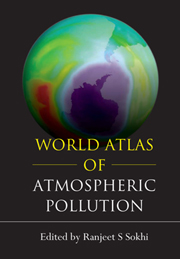Book contents
- Frontmatter
- Contents
- Contributors
- Foreword
- Preface
- Acknowledgements
- International Union of Air Pollution Prevention and Environmental Protection Associations (IUAPPA)
- Global Atmospheric Pollution (GAP) Forum
- Acronyms and Abbreviations
- Selected Units Used in Atmospheric Pollution Science
- INTRODUCTION
- CHAPTER 1 AIR POLLUTION HISTORY
- CHAPTER 2 AIR POLLUTION IN URBAN AREAS
- CHAPTER 3 LONG-RANGE TRANSPORT OF ATMOSPHERIC POLLUTANTS AND TRANSBOUNDARY POLLUTION
- CHAPTER 4 GLOBAL AIR POLLUTION AND CLIMATE CHANGE
- CHAPTER 5 OZONE DEPLETION
- CHAPTER 6 ENVIRONMENTAL AND HEALTH IMPACTS OF AIR POLLUTION
- CHAPTER 7 FUTURE TRENDS IN AIR POLLUTION
- References
- List of Useful Reading Material
- Index
CHAPTER 4 - GLOBAL AIR POLLUTION AND CLIMATE CHANGE
Published online by Cambridge University Press: 05 March 2012
- Frontmatter
- Contents
- Contributors
- Foreword
- Preface
- Acknowledgements
- International Union of Air Pollution Prevention and Environmental Protection Associations (IUAPPA)
- Global Atmospheric Pollution (GAP) Forum
- Acronyms and Abbreviations
- Selected Units Used in Atmospheric Pollution Science
- INTRODUCTION
- CHAPTER 1 AIR POLLUTION HISTORY
- CHAPTER 2 AIR POLLUTION IN URBAN AREAS
- CHAPTER 3 LONG-RANGE TRANSPORT OF ATMOSPHERIC POLLUTANTS AND TRANSBOUNDARY POLLUTION
- CHAPTER 4 GLOBAL AIR POLLUTION AND CLIMATE CHANGE
- CHAPTER 5 OZONE DEPLETION
- CHAPTER 6 ENVIRONMENTAL AND HEALTH IMPACTS OF AIR POLLUTION
- CHAPTER 7 FUTURE TRENDS IN AIR POLLUTION
- References
- List of Useful Reading Material
- Index
Summary
The increasing body of observations has shown that we are faced with a warming world and other changes in the climate system brought about by increasing anthropogenic (human induced) pollution of our atmosphere. The global average surface temperature has increased over the twentieth century by about 0.6 °C (IPCC 2001a). The Fourth Assessment Report (AR4) of the International Panel on Climate Change (IPCC) has re-estimated the global average surface temperature in light of new research and derived a slightly higher warming magnitude due to inclusion of several particularly warm years in this century (2003, 2004, 2005 and 2006) (IPCC 2007; Meehl et al. 2007). The changes in climate, with global warming as their major characteristic feature, are known to occur as a result of internal variability within the climate system and external factors (both natural and anthropogenic). Based on the conclusions derived by IPCC in their Third Assessment Report or TAR in short form (IPCC 2001b) and now in AR4 (IPCC 2007), there is new and stronger evidence that most of the warming observed over the last 50 years is attributable to human activities. As a result of these anthropogenic activities, concentrations of atmospheric greenhouse gases and their radiative forcing have continued to increasesince 1750 (the pre-industrial era), thus leading to global warming and significant environmental consequences. Now the emissions of greenhouse gases and aerosols are of major environmental concern throughout the world as an issue of global air pollution.
- Type
- Chapter
- Information
- World Atlas of Atmospheric Pollution , pp. 47 - 66Publisher: Anthem PressPrint publication year: 2008



